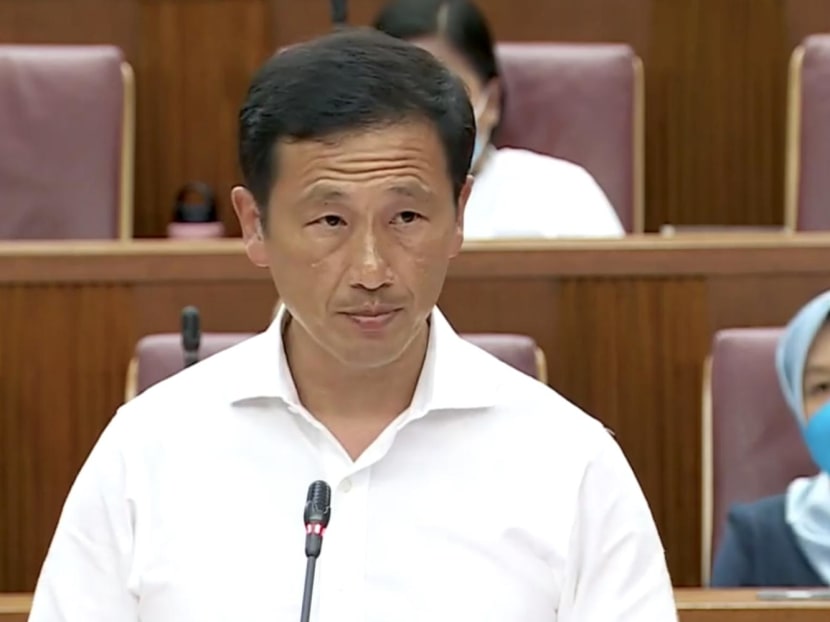MOH to be restructured to deal with future pandemics, including having permanent crisis strategy team: Ong Ye Kung
SINGAPORE — Drawing from the lessons learnt from the Covid-19 pandemic, the Ministry of Health (MOH) will undergo restructuring, including by retaining a permanent crisis strategy team.

- The Ministry of Health will undergo restructuring, drawing lessons learnt from the Covid-19 pandemic
- These changes include the maintaining of a permanent crisis strategy group and the set-up of a new Communicable Diseases Agency in the ministry
- Health Minister Ong Ye Kung said that restructuring after the 2003 Sars crisis had also aided Singapore in handling Covid-19
SINGAPORE — Drawing from the lessons learnt from the Covid-19 pandemic, the Ministry of Health (MOH) will undergo a restructuring of its operations, including retaining a permanent crisis strategy team.
Other reforms include the setting up of a new Communicable Diseases Agency and a Healthcare Reserve Force, Health Minister Ong Ye Kung said on Tuesday (March 21) in his speech during a debate on the Covid-19 White Paper.
Mr Ong noted that MOH had undergone a reorganisation after the severe acute respiratory syndrome (Sars) outbreak in 2003, which had led to the setting up of the National Centre for Infectious Diseases (NCID) and the National Public Health Laboratory (NPHL).
WHY IT MATTERS
Organisational enhancements made after Sars built up Singapore's healthcare capabilities, which in turn helped the nation respond to Covid-19, Mr Ong added.
For example, NCID provided high-standard infectious disease clinical management, while NPHL designed the polymerase chain reaction test just two days after scientists from China shared the first whole genome sequences with the world.
Given what Singapore has learnt from the Covid-19 crisis, Mr Ong said that it is time to review MOH's structure again, to be even better prepared for the next pandemic.
Singapore is not the only country doing so. Mr Ong said that many others are reviewing the organisation of their public health functions in the wake of the pandemic.
NEW AGENCY TO OVERSEE NCID, HOUSE NPHL
A new Communicable Diseases Agency will be set up under MOH to oversee disease preparedness, prevention and control, surveillance, risk assessment and outbreak response, with the following features:
- It will consolidate relevant public health functions that now reside in the ministry, NCID and the Health Promotion Board
- NPHL will be transferred to the Communicable Diseases Agency
- The Communicable Diseases Agency will maintain oversight of the clinical facilities in NCID
Mr Ong said that similar set-ups are already adopted in other countries such as South Korea, the United Kingdom and the United States.
MAINTAINING CRISIS STRATEGY TEAM
Another key part of the reorganisation is the retention of a permanent Crisis Strategy and Operations Group under MOH. This group was set up during the Covid-19 pandemic.
Comprising officers from different ministries, contract workers and full-time employees from affected industries such as airline and hospitality, the Crisis Strategy and Operations Group was “the machinery behind all the pandemic-related operations”, Mr Ong said.
These include contact tracing, home quarantine, conveyancing to isolation facilities, testing, vaccinations and home recovery.
Operations have since scaled down, but MOH will keep a permanent force with the Crisis Strategy and Operations Group to maintain surge readiness for a mid-sized outbreak and other health emergencies.
This includes preparing healthcare institutions to be crisis-ready.
The Crisis Strategy and Operations Group will also help operationalise the nationwide Healthier SG programme during peacetime, as the set of skills required are similar, Mr Ong said.
MAINTAINING RESERVE FORCE OF HEALTHCARE WORKERS
Thirdly, a Healthcare Reserve Force will be set up, made up of former healthcare workers and volunteers.
“We will train and equip them to reinforce our operations teams during larger surges, and they will complement the existing pool of SG Healthcare Corps volunteers,” Mr Ong said.
SG Healthcare Corps was launched in April 2020 to invite former nurses and other healthcare professionals in locum, who typically fill in for full-time workers who are away, or those in private practice, to help deliver medical care at public hospitals and community care facilities.
Finally, the title of the director of medical services at MOH will be renamed to director general of health. Professor Kenneth Mak is now the present director of medical services.
The renaming would more accurately describe the role as the main overseer of both clinical and public health of Singaporeans, Mr Ong said, adding that it will take place after the changes to the Healthcare Services Act come into effect later this year.
NEW CARE FACILITY IN THE WEST
Mr Ong also announced that another transitional care facility will be set up "in the coming months".
The facility will be located in the western part of Singapore in close proximity to Ng Teng Fong General Hospital, in Jurong East.
Five transitional care facility sites with 500 beds run by private operators were set up during the pandemic, for medically stable patients from public hospitals waiting for long-term care arrangements such as home care or nursing home care.
“The transitional care facilities have proven to be very useful. They're very well-utilised, and it is as good as adding 500 more beds to our acute hospitals,” Mr Ong said.
Earlier in his speech, the minister said that it was not realistic to plan for more hospital capacity in anticipation of a pandemic crisis and size the healthcare system to take on the "full brunt of the next pandemic".
Giving an illustration, there were 1,300 patients hospitalised and 140 in intensive care units at the peak of the infection wave in 2021 due to the Delta strain of the coronavirus, even with vaccinations and infection controls in place.
The numbers would "easily doubled, probably tripled" if infection control measures were relaxed at that time, Mr Ong added.
This is equivalent to three or four full general hospitals "set aside as spare capacity during peacetime" to be deployed during a surge.
"So it's just not realistic to set aside so much spare capacity,” he said.








